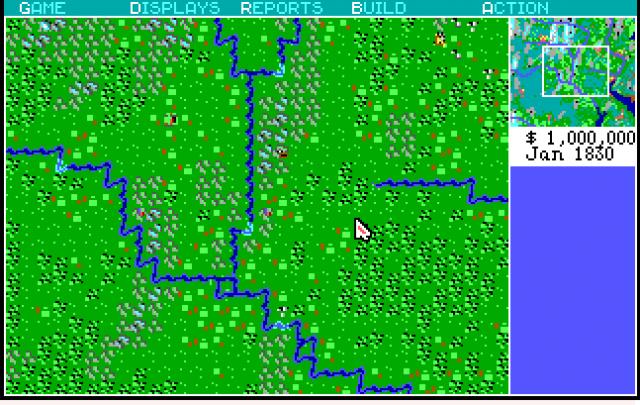Railroad Tycoon
Press Keyboard right side: Alt+Enter keys to switch to full screen game play, and Alt+Enter keys to return.
How to play Railroad Tycoon
Game only runs in keyboard/mouse mode/you need to use the number keypad on a full keyboard, number lock on! to build tracks.., remember to be in detailed view.
North numeric keypad `8' key
Northeast numeric keypad `9' key
East numeric keypad `6' key
Southeast numeric keypad `3' key
South numeric keypad `2' key
Southwest numeric keypad `1' key
West numeric keypad `4' key
Northwest numeric keypad `7' key
Railroad Tycoon Description
The player may start companies in any of four geographic locales: the Western United States, Northeast United States, England, or Europe. The company starts with one million dollars in capital; half equity, half a loan. The company may raise additional capital through the sale of bonds.
The player manages the business as described above and may also handle individual train movement and build additional industries. The game also has other railroad companies attempting to put the player out of business with stock dealings and "Rate Wars".
There are four types of stations: Signal Tower, Depot, Station, and Terminal. The Signal Tower acts as a passing loop and may control movements. The rest service surrounding areas: the Depot serves its own square and the adjoining eight squares, the Station takes another ring, and the Terminal handles up to three squares away. The player can build at most 32 stations. When the player builds the first station they also build their first engine shop. Each engine shop is the manufacturing area for the player's different trains. The player can upgrade and downgrade Depots, Stations, and Terminals. Other facilities such as cool stores and hotels may be added.
Once the player builds a station they can build their first train (of the 32 permitted) at any engine shop. The player then can add cars to the train and send it on its way. The player can at any time change the "consist", which is the list of cars the train is to pick up at the various stations along the way. These include pure mail and passenger cars and specialized freight cars for each of the other nine types of commodity produced in the game.
The player can continue to build the track network and build stations until the player runs out of funds. The game runs for a century, with accounting periods two years long. Stations built or rebuilt in a particular accounting period pay the player double freight rates for everything they purchase in that period. It can be worthwhile rebuilding busy ones every two years.
Mail pays much better when delivered quickly. Other cargoes also pay better for faster delivery, but at the "bulk" end of the scale there is little advantage (the manual incorrectly says there is none). It is usually better to hold a train at a source station until several bulk cars are full before setting off.
Train speed is a factor to be considered when laying track. Saving money up front by laying track straight over a mountain instead of around on the plains or through an expensive tunnel may cause slow trains which lose money in the long run. Similar considerations apply to ferries, which are expensive and slow-running but may in some cases be economic if they greatly shorten a distance.
Not every station buys everything offered to it. Some good producers buy nothing. There are two alternatives the player can choose between: Simple Economy (where, for example, a station serving two or more cities will buy anything) and Complex Economy (where "two cities" will buy mail, passengers, and a couple of other products; "four villages" will buy passengers and different freight products; only a station with a steel mill will buy coal; and other products have other buyer types). There are product variations over the four geographical scenarios.

Railroad Tycoon - additional information
















